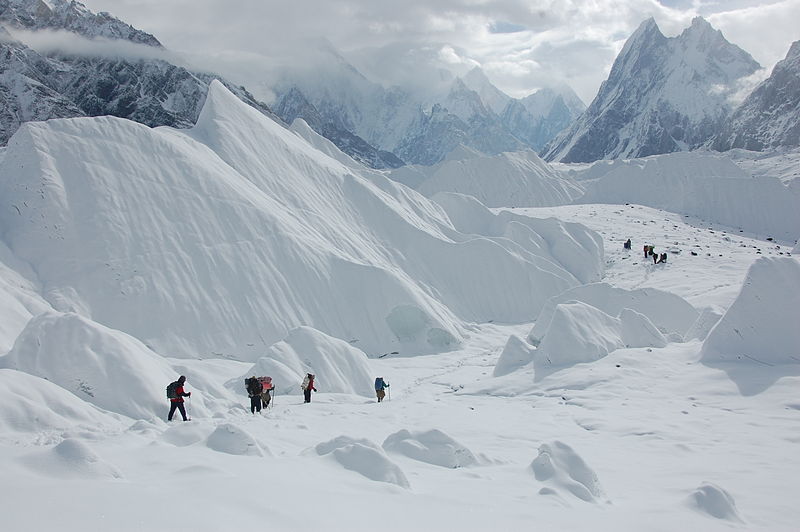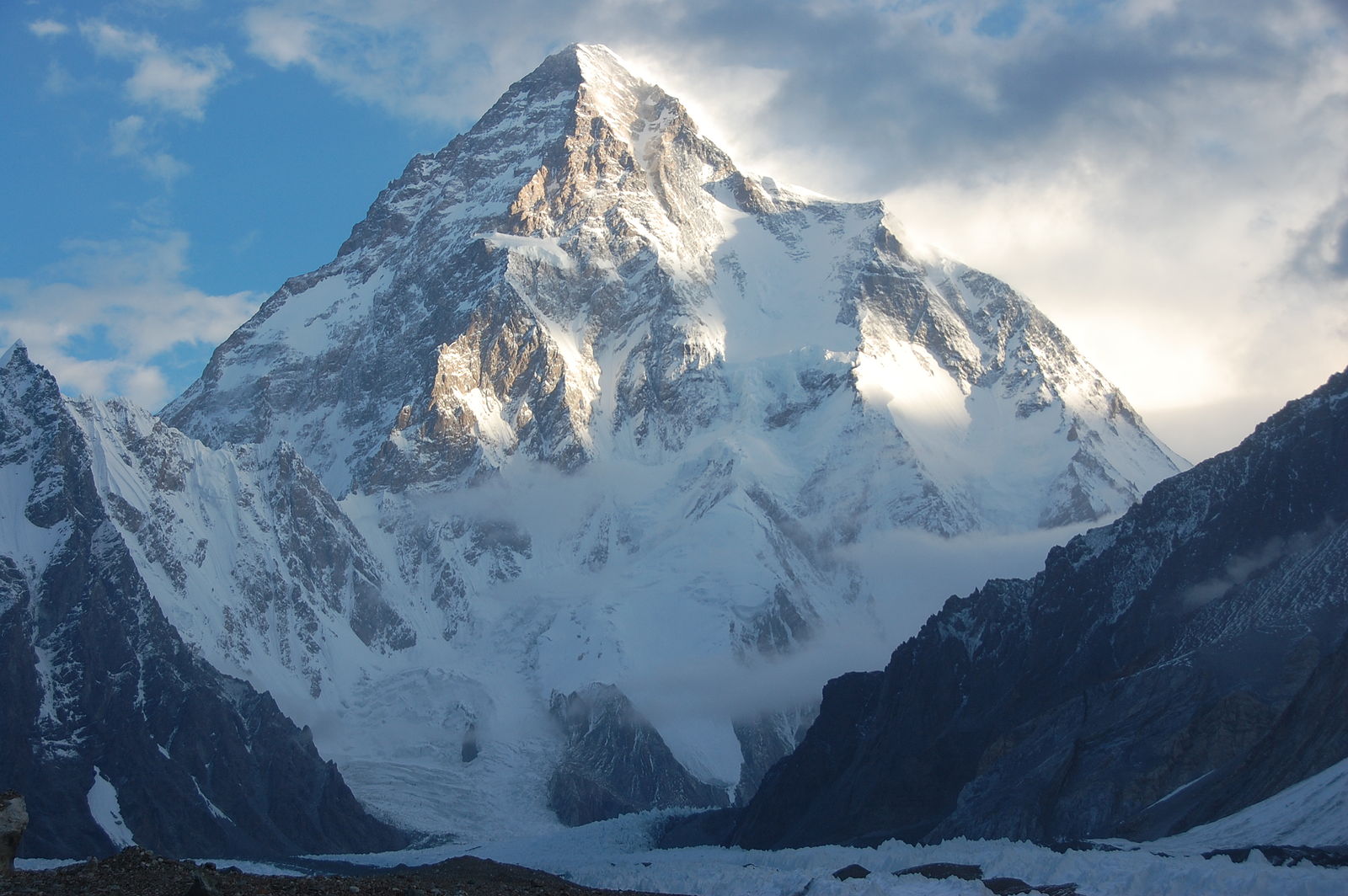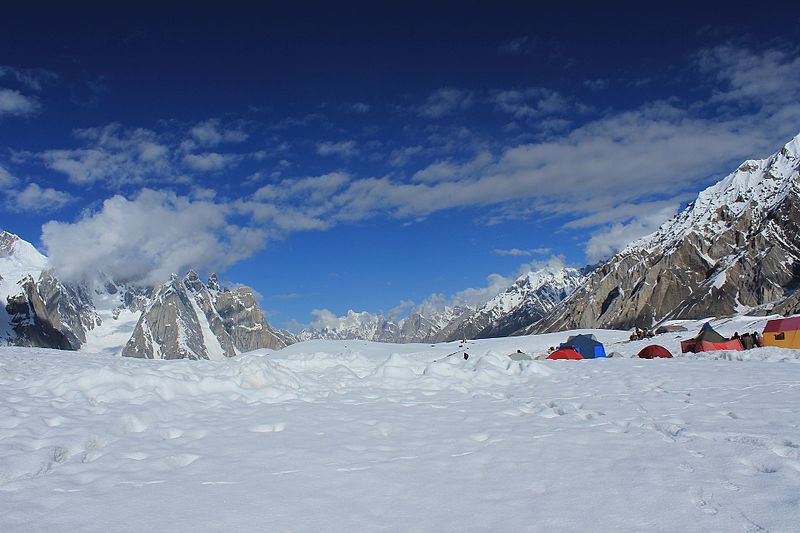Concordia Trek
Key information: Concordia Trek 
- A classic but difficult trek, much of it on tricky glaciers, to the great glacier junction at Concordia, under K2, the world’s second highest peak. Some of the finest scenery anywhere.
Walkopedia rating
(Top 100)
- Walkopedia rating89
- Beauty39
- Natural interest18
- Human interest6
- Charisma38
- Negative points12
- Total rating89
Vital Statistics
- Length: 20 days
- Maximum Altitude: 5,585m
- Level of Difficulty: Very Difficult
This walk description page is at an early stage of development, and will be expanded over time. Your comments on this walk, your experiences and tips, and your photos are very welcome.
WALK SUMMARY
A classic, but difficult, gruelling, trek into the heart of the Karakaram range, much of it on tricky glaciers, to the great glacier junction at Concordia, under K2, the world’s second-highest peak at 8,611m.
Some of the finest scenery anywhere – an astonishing array of vast peaks and achingly beautiful spires, seen from the vast Gondokoro and Vigne/Baltoro Glaciers. Four of the world’s 14 peaks over 8,000m cluster around Concordia.
Beginning at Hushe (10hrs (still?) from Skardu), the walk in to Concordia takes some 12 days (including an acclimatization climb of the walkable peak of Gondokoro mountaineering), including a tough mountaineering crossing of the ice-and-rock Gondokoro La (at 5,583m). You will want to take some days at Concordia (at a relatively mild altitude of around 4,700m) to admire the amazing surrounds.
You can retrace your steps to Hushe, or head south-west down the Baltoro Glacier to Ashoke, a 7 days-or-so descent without major altitude issues. Indeed, the Baltoro route is the quicker (13+ days) and much less altituditious approach (and with less glacier-negotiating) if you don’t fancy rock climbing on Gondokoro La.
This is a very tough trek, with significant time on lethal glaciers in high, remote mountains, on which you will have to be self-sufficient and where altitude can kill (several nights over 5,000m). Glacier experience is required. Reinhold Messner on the 5,5855m Gondokoro La: “It is a good way – but not for trekkers!”; it needs an ice-axe and crampons and ropes, and helmets are recommended as rock-fall is a risk.
Given how unstable, indeed dangerous, Pakistan can be, check the current security situation carefully before trying this trek.
When to go: June to early September.
Permits required.
ANYONE GOT ANY GOOD PHOTOS? WE WOULD BE DELIGHTED TO POST THEM!
We want to tell more - please send us your ideas, suggestions, experiences and photos. Thank you!
OUR FRIENDS' EXPERIENCES
From Walkopedia user Dugite - Walko says thank you!
In August 2000, I joined a World Expeditions Challenging Trek to K2 Base Camp (K2 being the world’s 2nd highest mountain located in the Karakoram Mountains in north west Pakistan).
After flying into Skardu from Islamabad, the outward journey took us on a cliff-edge nail-biting jeep ride to Thungol, then on foot for ten days up the Baltoro Galcier to Concordia (passing en-route the awesome peaks of Great Trango (6,286m) and Masherbrum (7,821m)), and then via the Godwin-Austen Glaciers to the climbers’ memorial 100m up from the base of K2 (8,611m), passing more awesome peaks of Gasherbrum IV (7,925m), and Broad Peak (8,047m).
Perfect weather whilst at Concordia produced magnificent views, particularly of K2 at the head of the Godwin-Austen Glacier.
The normal and safer return route from Concordia is back down the Baltoro. However, providing everyone in the trekking group is fit enough, and weather conditions permit, there is a very attractive, but more challenging alternative for the adventurous – over the Gondogoro La (5,940m) and out through the Hushe Valley. The advantages of this exit are the magnificent early morning views of K2 and surrounding peaks from atop the pass, the different scenery, a rest day, and a much easier jeep ride from Hushe to Skardu. The downside is the exhausting high-altitude climb up to the pass, and the lack of sleep on the night you set off, having to strike out from Ali Camp just after midnight in order to get over the ridge before the rising sun causes an avalanche or rock fall on the southern side. Our Pakistani guides believed our group could make it, and the weather was ideal, so we.....
READ MOREYour comments on this walk, your experiences and suggestions, and your photos are very welcome. Where appropriate, you will be credited for your contribution.
Safety and problems: All walks have inherent risks and potential problems, and many of the walks featured on this website involve significant risks, dangers and problems. Problems of any sort can arise on any walk. This website does not purport to identify any (or all) actual or potential risks, dangers and problems that may relate to any particular walk.
Any person who is considering undertaking this walk should do careful research and make their own assessment of the risks, dangers and possible problems involved. They should also go to “Important information” for further important information.
Anyone planning an expedition to this place should see further important information about this walk.
Responsible travel matters, a lot. How you travel will make a real difference - for better or worse. PLEASE consider this when making plans. Read more









